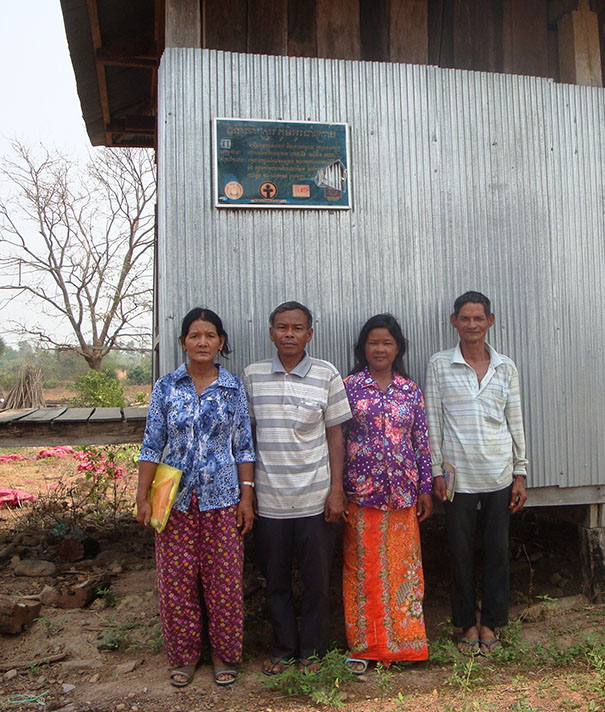
Pen Reth (left) and her team manage the rice bank in Ou Choam Kraom village in Battambang province, Cambodia. Photo: CWS Cambodia
Imagine, for a moment, that you are a poor farmer in rural Cambodia. You and your husband or wife are trying to make ends meet and take care of your young children. There are only 65 or so families in your community. Most are in the same situation you are – trying to get by year after year.
Sometimes you have a great year! The weather cooperates, and the crops on your land grow well. Your family has enough to eat, and you can sell some extra crops to pay for more ingredients, some household goods and even health care services or school fees.
Other years things don’t go as well: the weather isn’t as hospitable and a long dry season lessens your harvest. Or someone in your family gets sick, so you have to spend precious time and other resources taking care of them. Inevitably, other challenges arise, too.
How will you feed your family? How will you make it through months of not having enough food before the next harvest?
Unfortunately, this is a real predicament faced by too many Cambodian families and, often, the only solution is to borrow rice. Fortunately there are well-off families nearby who are willing and able to share their rice. But, of course, they must be repaid eventually.
To start to move beyond this cycle of debt, and with help from CWS partners the Khmer Community Development Association and Co-operation for Development of Cambodia, families in small villages across Battambang and Kampong Thom provinces in northwest and central Cambodia are working together to provide a better alternative: rice banks.
Much like village savings and loan associations, where members save and lend money, rice banks are storage facilities that hold surplus rice, which members save gradually in small amounts. As with cash groups, they also lend. But, instead of cash, they lend rice – either for families to eat when their household stocks run out or to use as seed rice for future harvests. As with cash borrowing, people must repay what they borrow. But, interest rates are also low; families can pay the rice bank back in rice or in cash, and there is flexibility in the payment plan.
In Ta Triel village in Kampong Thom’s Stoung district, 75 families established a rice bank in 2014 with support from CWS and CDC, which provided information, training and coaching about how to manage a rice bank and how to mobilize resources to build a storage facility. An initial CDC donation of 11,000 pounds of rice helped get the bank started; then Seng Va, a community leader, organized a team of other community members who now manage the bank. Interest rates from this rice bank were set at 15 percent – in rice or in the cash equivalent value of the borrowed rice – compared to 50 percent from private lenders.
Two years in, Ta Triel’s bank has grown to hold 24,400 pounds of rice, so members can borrow rice whenever they needed to. Even with drought this year, there was enough for all. Va told us, “I am always happy when I talk with people in neighboring villages about the progress of our rice bank. I am very proud of it and I am committed to work hard to increase our membership.”
In Ou Choam Kraom village in Battambang province, 50 families established a rice bank under the leadership of one of their community leaders, Pen Reth. What started as 13,000 pounds of rice has grown to more than 25,000 pounds.
Private lenders in the area were charging up to 100 percent interest per season! For example, to borrow 50 kilograms (110 pounds) of rice, a family would eventually have to repay 120 kilograms (265 pounds). Some families then had to borrow other food and supplies, too, or they had to migrate to find work for pay. Both alternatives left them in an even more precarious situation.
To start to address these complex and compounding challenges in her village, Reth and her team settled on just two percent as the interest rate for their rice bank. Additionally, they agreed that members who can’t manage to pay back the rice they borrowed in one year due to low productivity or other problems, they can defer their payment to the next year.
This year, Ta Taok village in Battambang province also has a new rice bank, which is managed by their Village Development Committee; and another village, Sok San, now has 17,000 pounds of rice in its rice bank. And so the list of villages with rice banks goes on.
For these communities, and many others with which CWS has partnered through the years, one key solution to hunger is rice. But it isn’t the rice alone that makes the difference. It is community members’ ability to stand together and support one another, allowing everyone to survive – and even thrive. Of course, our CWS team is proud to stand with them.
